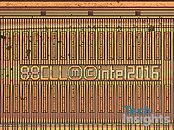Friday, June 29th 2018

Intel 10 nm Process Increases Transistor Density by 2.7x Over 14 nm: Report
Intel's 10 nanometer FinFET silicon fabrication is coming together at a slower than expected rate, however when it does, it could vastly enlarge the canvas for the company's chip designers, according to a technical report by Tech Insights. The researchers removed the die of an Intel "Cannon Lake" Core i3-8121U processor inside a Lenovo Ideapad330, and put it under their electron microscope.
Its summary mentions quite a few juicy details of the 10 nm process. The biggest of these is the achievement of a 2.7-times increase in transistor density over the current 14 nm node, enabling Intel to cram up to 100.8 million transistors per square millimeter. A 127 mm² die with nothing but a sea of transistors, could have 12.8 billion transistors. Intel 10 nm node also utilizes third-generation FinFET technology, with a reduction in minimum gate pitch from 70 nm to 54 nm; and minimum metal pitch from 52 nm to 36 nm. 10 nm also sees Intel introduce metallization of cobalt in the bulk and anchor layers of the silicon substrate. Cobalt emerged as a good alternative to tungsten and copper as a contact material between layers, due to its lower resistance at smaller sizes,
Source:
Tech Insights
Its summary mentions quite a few juicy details of the 10 nm process. The biggest of these is the achievement of a 2.7-times increase in transistor density over the current 14 nm node, enabling Intel to cram up to 100.8 million transistors per square millimeter. A 127 mm² die with nothing but a sea of transistors, could have 12.8 billion transistors. Intel 10 nm node also utilizes third-generation FinFET technology, with a reduction in minimum gate pitch from 70 nm to 54 nm; and minimum metal pitch from 52 nm to 36 nm. 10 nm also sees Intel introduce metallization of cobalt in the bulk and anchor layers of the silicon substrate. Cobalt emerged as a good alternative to tungsten and copper as a contact material between layers, due to its lower resistance at smaller sizes,



28 Comments on Intel 10 nm Process Increases Transistor Density by 2.7x Over 14 nm: Report
Intel 14nm is more advanced than GloFo 12nm (Ryzen refresh)
I expect Intel 10nm by late 18 or early 19. Intel might get in trouble if not ready for Zen 2 release. We have started seeing Intel small die 10nm chips, looks like progress
But the thing is, when Intel releases mass produced 10nm products, it'll be on 10nm+ or some sort of evolution/optimization. So that one might be better than standard 7nm. Then again the competition will move to 7nm+ EUV or whatever it's gonna be. It's gonna go back and forth.
Also, for all its troubles, if the end result is an almost 3x density, Intel will have quite the advantage over the competition once they fully flesh 10nm out. And I'm pretty sure at their next node, everybody else will need to figure out quad-patterning as well.
In short density isn't everything, in fact when you're packing billions of transistors it's best to look elsewhere for other advantages wrt competition in GF & TSMC.
Fwiw, that graph also says14nm++ is leaps and bounds faster than plain 14nm. But we all know the resulting CPUs aren't.
Intel's 14nm as a process probable maxes out at around 5 GHz for the frequency. At reasonable voltage/power consumption, that is. And this does not seem to depend on the size at all.
At the same time, both density and lower power are what drives everyone including Intel to smaller node.
Anyway the point is 10nm is turning out to be a bigger can of worms than what Intel could've ever imagined, even in their worst nightmares.
If anything I would expect 6-Core on 10nm to be shrinked to 50 sq.mm. not Dualcore to be 127.
For comparison, the same 2 cores along with 24 EU iGPU in Kaby Lake are 127 mm² at 14 nm process.
Granted, GloFo seems to be planning to skip 7 nm and go straight to 5 nm but we will see how this goes.
At this point, TSMC and GloFo actually seem to be having slightly lower transistor density at respective 7 nm processes than Intel at 10 nm. Samsung has a bit better but their 7 nm is at about the same stage where Intel is with 10 nm. We don't know much about yields beyond the fact that TSMC is doing volume production which we can assume means OK yields.
Production process is the foundation of entire Intel business, not just CPUs. We can safely say Intel is putting everything it can into making their 10 nm process work to stay competitive.
jesus, can you imagine that. Some of the simpler chips (remember, Pentium III had 9.5 million transistors) can be manufactured in submilimeter sizes.